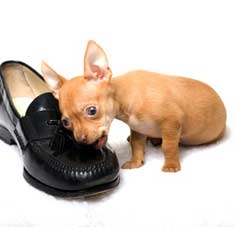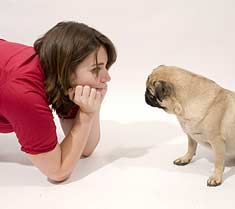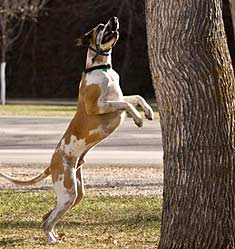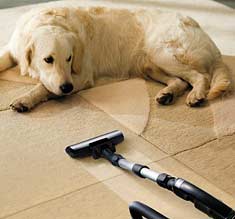Shaping Your Dog’s Behavior
There are many different training methods sworn to by various trainers. Some advocate using a clicker. Others want you to show your dog you are the leader of the pack. Still others say you must use a very stern voice to show your dog you are displeased with his behavior. Which one is right for your dog? How do they all work?
Discipline vs. Punishment

No matter which training method you choose, it is vital that you learn the distinction between discipline and punishment. Punishment is about making the dog “pay” for his wrong-doing. Discipline, on the other hand, involves you teaching and your dog learning the desired behaviors. For example, if a dog uses your new living room carpet as a bathroom, a punishment might be to yell at him or to rub his nose in it. Although this lets him know he did something wrong, it doesn’t really teach him the right thing to do.
Considering that your desired outcome is to have your dog go outside or to his newspapers when he has to go to the bathroom, you will be much further ahead if you teach him where you want him to go than if you simply punish him for going in the wrong place.
Why do dogs misbehave?
Dogs generally do bad things for one of three reasons:
- They don’t know any better
- They can’t control their behavior
- They want attention
Puppy behavior usually falls into one of the first two categories. They chew on your stuff because they don’t recognize the difference between what is yours and what is theirs. They go to the bathroom in the house because their bladders are not big enough to wait until you take them outside. Punishing a dog at this stage serves no useful purpose.
However, as a dog moves beyond the puppy stage, chances are his behavior is tied to his desire for your attention and love. Many dogs simply can’t get enough love, and they will accept nothing less than all of your time and energy. The dog doesn’t particularly care if he is getting positive attention or negative attention; he simply wants you to interact with him.
Where do I start?
It’s important to work on only one or two behaviors at any one time for two important reasons. One is that dogs have very short attention spans, so you will not be able to keep the dog involved for long enough to teach too many things at once. The second reason is that training will be much more successful if you are consistent. Working on just one or two behaviors at a time keeps you from having to constantly jump up and correct the dog for everything that crops up.
Make a list of the things your dog does that annoy you. Classify each item on your list according to the following groups:
- Family Safety
- Dog Safety
- Property destruction
- Major annoyances
- Minor annoyances
- Would be nice if…

Obviously, your first obligation is to keep your family safe, so if you have any behaviors that fall into this category, they will be the first ones you will want to work on. For example, if your dog nips at your two year old, you need to extinguish that behavior before the child gets hurt. The next most important category is keeping the dog safe. Things that fall in this category might be chasing cars or eating things that are not food. If you have nothing listed in either of these categories, you can begin working on things the dog does that result in property destruction or those things that are simply annoying or would be nice to have.
Once you have selected your top two behaviors to target, you must simply ignore the remainder of the behaviors until you have conquered the top two. Once the dog stops doing the dangerous things, you can move on to the destructive or annoying things.
What do I do once I have picked which behaviors to work on?
Remember that you want to teach your dog the right thing, not just discourage him from doing the wrong thing. For each behavior you don’t like, you will need to think of a replacement activity. For example, if your dog is chewing your slippers, you might want him to chew on his toys instead. If he is barking too much, you will want him to find another way to alert you to whatever he perceives as a hazard. Alternatively, you will need to show him that not everything is hazardous.
Next, you need to redirect your dog to the thing you want him to do. In the case of chewing, simply take the slippers away from the dog and hand him the chew toy. When he begins to chew on the toy, praise him and give him a treat. Spend time playing with him with the toy so he sees that when he chews on the right thing, he can get your attention in a much better way than when he does the wrong thing.
The key is praise
Your praise and attention, as well as a few well-timed bacon treats, are the biggest drivers to get your dog to do what you want him to do. Whether you choose to associate your praise with a clicker or with being the alpha dog in the pack, the key to dog training success is to make sure there is no question in your dog’s mind when he has made the right choice.
Another important component is to develop a good relationship with your dog in the first place. Spend time with him every day, whether you play with him in the yard, take him for a walk, or drive him to the ice cream stand. Teach him that you are trustworthy and will never hit him. Expose him to new and exciting situations so he becomes accustomed to people and sounds outside his normal environment.

Stop that incessant barking!
If your dog barks at everything he sees, it is likely that he is either scared or excited by the things in his environment. Observe him to find out which. A scared dog will need to be acclimated to the new things around him so they aren’t so scary anymore. For example, if he is scared of the vacuum and barks every time he sees it, you may be able to get some relief if you sit on the floor with your dog while someone brings the vacuum just to the doorway of the room.
Allow your dog to see the vacuum, but keep him distracted by playing tug with him or throwing a ball for him to chase in the opposite direction from the vacuum. Praise him for interacting with you rather than obsessing over the vacuum. Have your helper bring the vacuum a little closer while you keep playing with the dog. Once you can bring the vacuum up next to the dog without his freaking out, move the vacuum out of sight and turn it on. Repeat the exercise, bringing the running vacuum closer and closer to the dog.

Take it slowly. This exercise may take weeks before your dog is confident enough to ignore the running vacuum up close. Spend just a few minutes each day until he has conquered his fear.
The technique is somewhat similar for a dog who is excited by, for example, a squirrel running through the yard. Remember that many dogs were bred to bark at prey during a hunt, so this is somewhat inbred. However, if your dog cannot stop himself after a reasonable period of time or when the squirrel has moved on to the neighbor’s yard, it’s time to intervene.
In this case, you will work on calming the dog down as the squirrel gets closer to you and the dog. When the dog first notices the squirrel from far away, have him sit down. As soon as his butt hits the ground, praise him and give him a treat. If he stays seated, continue to talk to him. Once he gets up or barks, withdraw your attention. Turn away from him and totally ignore him. When the squirrel is gone, call the dog to you and have him sit again, praising him when he does. Your dog will soon learn that he gets your attention better by sitting than by barking.
Other behaviors

The method for stopping other behaviors is pretty much the same as that for barking. Your job is to show your dog that he will get more from you by doing what you want him to do than by misbehaving. Give him something positive to replace the negative behavior, and praise him like there’s no tomorrow when he does what you want him to. Make sure your dog has the opportunity to get comfortable with things that scare him. Give him lots of opportunities to succeed by spending a lot of time with him, focusing on the behaviors you want to see and teaching him to trust you.
Above all, be patient. If your dog has been doing something for a number of years, you are not going to train him to give it up in a day. It may take weeks of consistent work to get him to learn a new way to react.
Doggies Den: Latest Articles
 Homemade Thanksgiving Treats for Your Dog
Homemade Thanksgiving Treats for Your Dog
NUTRITION We all want to include our dogs in our holiday celebrations, but hopefully, you're aware that sharing table scraps with your dog isn't always the best idea.
 Keeping Your Dog Safe during the Summer Months
Keeping Your Dog Safe during the Summer Months
HEALTH Summer is coming on fast, so it’s time to plan how you will keep your dog safe and healthy through the lazy, carefree, warm days.
 Vaccination Time Again-Keeping Your Puppy Healthy
Vaccination Time Again-Keeping Your Puppy Healthy
DOG HEALTH So you have your new puppy picked out. There are quite a few shots, treatments and examinations that will keep the newest member of your family healthy.
 Canine Thanksgiving Feast
Canine Thanksgiving Feast
NUTRITION With the wide variety of food at Thanksgiving dinner, chances are you'll want to give your dog something special, too. If you're contemplating what to feed your dog for the holiday, here is a guide to a great Canine Thanksgiving Feast.
 Dog Walking Tips Every Owner Should Know
Dog Walking Tips Every Owner Should Know
DOG FUN Walking your dog is not only crucial to keeping him healthy and happy, it strengthens the bond between your canine friend and his caregiver. There are a lot of obstacles out there. Don’t forget these simple tips to keep your walk fun and safe in the outside world.
 The Benefits of Physiotherapy for your Dog
The Benefits of Physiotherapy for your Dog
HEALTH The same techniques that physiotherapists use to treat a variety of injuries and conditions in humans have been adapted to suit animals with great success. Family pets, show dogs, and working dogs can all benefit greatly from physiotherapy. Dogs whose activities involve a lot of agility are especially susceptible to the types of problems that physiotherapy can address.
 The Decision- Adding a Dog to Your Family
The Decision- Adding a Dog to Your Family
FIRST TIME OWNERSBringing a dog into your family is a decision where many people don’t realize it’s magnitude until after they have the dog. There are a number of things that you need to research before you decide to purchase a dog, and it starts right in your own home.
 Bringing Your Dog Into Your New Baby's Life
Bringing Your Dog Into Your New Baby's Life
HEALTH Many believe that a dog and a new baby cannot happily coexist, so therefore the dog has to go. This is not necessarily the case.  A new baby does not mean you have to abandon your dog.

Doggies Den:
Most Popular Articles

Dog Pregnancy Symptoms
HEALTHIf you suspect your dog might be pregnant, check out part one in this series on pregnant dogs, where we cover pregnant dog symptoms.

Dog Birth
HEALTHIn the third article of our dog pregnancy series, we look at the wonderful, but messy, process of bringing newborn puppies into the world.

Indoor Dog Potties
DOG PRODUCTSIt's been a long day at work. You were so busy, you didn't even take time to eat a sandwich, let alone run home to let your dog out. You're on your way home, knowing the poor dog is crossing his or her legs by now, when your car breaks down, delaying you even further. Can't somebody make this easier?

Your Dog’s Digestive System
PHYSIOLOGYEver wonder why your dog eats so fast? Or why he eats gross things? Or why he gets sick to his stomach? Or why his waste stinks so bad? Some of these things are normal, some are not.

Canine Respiratory System
BREATHINGThe basic function of your dog's respiratory system is to bring oxygen in to and remove carbon dioxide from the body. Knowing the symptoms of respiratory diseases can help you help your stay healthy.

Shelter Dog Adoption Tips for Success
ADOPTION Are you intimidated by the prospect of "rescuing" a dog from a shelter? One reason that you may be wary of adopting a dog from a shelter is not knowing how to choose. Adopting a dog from a shelter can be a rewarding process, if you're prepared to do a reasonable amount of research.

Canine Urinary Tract Infections
SYMPTOMS AND TREATMENTDoes your dog seem to be having trouble relieving his or her bladder? Learn how to recognize the signs of urinary tract infections and how to treat them before they spread.

What to do for Dog Diarrhea
SYMPTOMS AND REMEDIESIf you have dogs in your house for any length of time, you have likely experienced at least one bout of dog diarrhea. Beyond the pain in the tuckus involved in cleaning up the mess, you should know what causes diarrhea, and when it's important to see the vet.

What to do for a Dog Bite
DOG BEHAVIOR Getting bitten by a dog can be scary, and you may be tempted to run around in circles for a while, trying to figure out what to do. Here's our guide to help you manage the situation.

Top Ten Tips for Living with a Senior Dog
DOG HEALTH Bringing home a new puppy is so exciting, but it doesn’t take all that long for your exuberant puppy to grow into a senior dog who may have special needs. Here are the doggies.com top ten tips for taking care of your companion who has been with you through so much.
